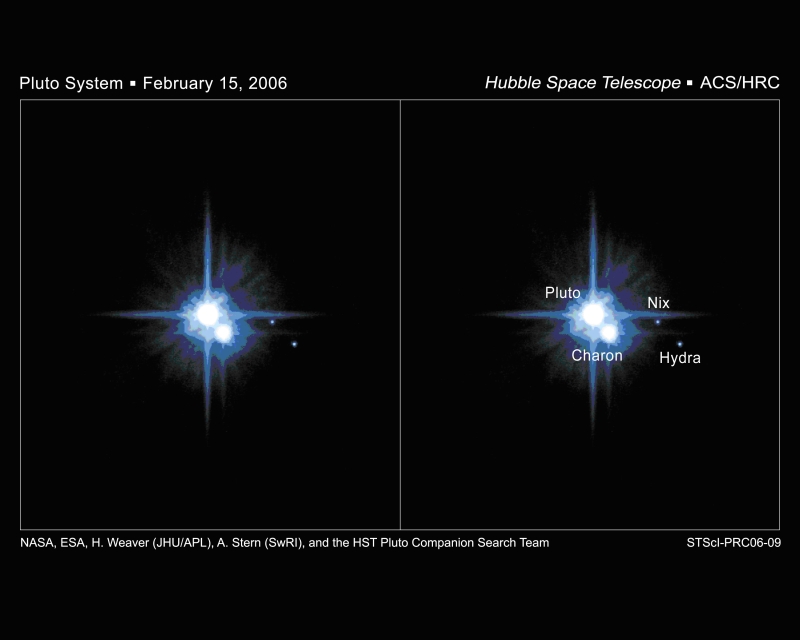V838 Monocerotis. You might not remember the name, or even be able to pronounce it, but you’ve seen the pictures. The Hubble Space Telescope first captured images of this amazing star erupting material in 2002, and then photographed it again in subsequent years. A huge cloud of gas and dust, light-years across, is being illuminated before our eyes. But what caused the outburst that set off this explosion? One team of astronomers think we might be looking at the violent deaths of V838 Monocerotis’ planets as they’re consumed.
Continue reading “Did V838 Monocerotis Eat Three Jupiters?”
Pluto’s New Moons are Named Nix and Hydra

The International Astronomical Union approved new names for Pluto’s recently discovered tiny moons. Previously designated S/2005 P 1 and 2, the moons will now bear the names Hydra and Nix. In mythology, Nix is the goddess of darkness and night, while the hydra is a monster with the body of a serpent and nine heads. Although they’re faint dots right now, NASA’s New Horizons probe will fly pas them in 2015, and map them in much more detail.
Continue reading “Pluto’s New Moons are Named Nix and Hydra”
Delta II Launches Micro-Satellite Technology Experiment
A Boeing Delta II rocket blasted off on Wednesday carrying an experimental satellite for the US Military. The rocket lifted off at 2315 GMT (6:15 pm EDT) from Launch Complex 17A at Cape Canaveral Air Force Station in Florida, and the satellite payload separated 30 minutes later. The payload is the Micro-Satellite Technology Experiment (MiTEx), which is designed to test how well off-the-shelf equipment will perform in space. If successful, it should help reduce the cost and development time for future satellites.
Continue reading “Delta II Launches Micro-Satellite Technology Experiment”
Pluto’s Planethood Will Be Decided Shortly
Pluto has been considered a planet since its discovery, but this position has come under threat with the discovery of 2003 UB313 (aka Xena), an object larger than Pluto orbiting out further in the Solar System. The International Astronomical Union will be meeting in August to decide on the fate of Pluto. By September, we could have 8 or 10 planets in the Solar System, but there won’t be 9 any more.
Continue reading “Pluto’s Planethood Will Be Decided Shortly”
Enceladus Passes Before Titan
This natural colour photograph from Cassini shows Saturn’s moon Enceladus passing in front of Titan. With this colour view, it’s easy to see how different these two moons are. Titan has its golden, smoggy atmosphere, while Enceladus is mostly gray, darkened ice. Cassini took this image on February 5, 2006 when it was 4.1 million kilometers (2.5 million miles) from Enceladus.
Continue reading “Enceladus Passes Before Titan”
Magnetic Fields Help Black Holes Pull In Matter
Even though the gravity from black holes is so strong that light can’t even escape, we can see the radiation from the superheated matter that’s about to be consumed. Until now, scientists haven’t been able to explain how all this matter continuously falls into the black hole – it should just orbit, like planets going around a star. New data from the Chandra X-Ray Observatory shows that a black hole’s powerful magnetic field creates a turbulence in surrounding matter that helps drive it inward to be consumed.
Continue reading “Magnetic Fields Help Black Holes Pull In Matter”
Everything’s on the Menu for Supermassive Black Holes
The supermassive black holes that lurk at the heart of most galaxies have enormous appetites. They’ve already consumed millions of times the mass of our own Sun, and they’re not done yet. Everything’s on the menu: mostly gas, dust, planets and stars, but the occasional exotic delicacy gets consumed too. “Compact objects”, such as stellar mass black holes, neutron stars, and white dwarfs occasionally fall into their grasp too. But these objects don’t go with a whimper; they make screams we’ll soon hear across intergalactic space.
Continue reading “Everything’s on the Menu for Supermassive Black Holes”
The Clearest Skies on Earth
Telescopes are perched at the tops of mountains because the air up there is thinner, drier and clearer than the view from sea level. But the best views of all are near the south pole in Antarctica, in a region called Dome C. With its high altitude, low temperatures, and crystal clear skies, Dome C boasts nearly perfect viewing conditions. A team of French astronomers are hoping to build a trio of telescopes that work together as a single, large telescope as a prototype. But they’ve got their sights set on a larger installation that could rival the capabilities of the best telescopes on Earth. It’s all about location, location, location.
Continue reading “The Clearest Skies on Earth”
Astrophoto: M83 by Michael Sidonio
Scientists have known the universe is expanding for over eight decades. During this period, many speculated that gravity would eventually slow and halt the expansion then the universe would probably start to contract. This common view held that the universe repeatedly oscillated between Big Bang and Big Crunch. Then, in the late 1990’s, some scientists realized that the brightness of exploding stars in very remote galaxies were not following the predicted theoory. They concluded that the expansion of the universe was not decelerating. It is speeding up.
Continue reading “Astrophoto: M83 by Michael Sidonio”
Phoenix Lander is Coming Together
NASA’s next mission to the surface of the Red Planet is the Phoenix Mars Lander, due for launch in August 2007. This week, engineers at the Phoenix Science Operations Center at the University of Arizona began connecting science payload instruments to a mock lander to see how well the components work with each other. Phoenix will touch down onto the surface of Mars in 2008, and examine the soil for evidence of past water, and to see if the habitat has the potential to support life.
Continue reading “Phoenix Lander is Coming Together”
